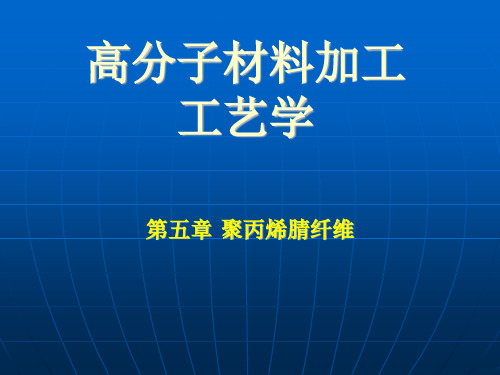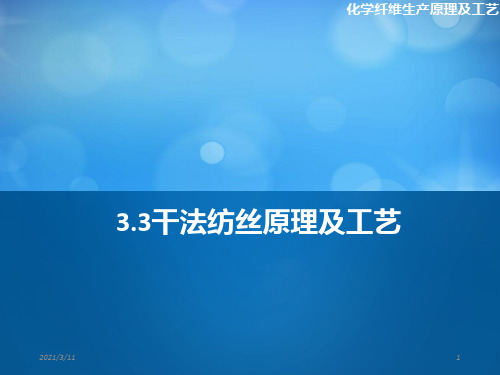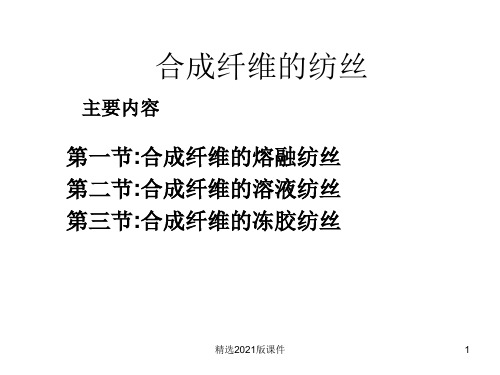合成纤维第五章干法纺丝
- 格式:ppt
- 大小:158.00 KB
- 文档页数:4


第五章化学纤维一、名词解释:1、高聚物2、再生纤维3、人造纤维素纤维4、合成纤维5、毛型纤维6、中长纤维7、消光纤维8、着色纤维9、复合纤维10、双组分纤维11、异形纤维12、超长纤维13、倍长纤维14、异长纤维15、熔融法纺丝16、溶液纺丝17、湿法纺丝18、干法纺丝19、差别化纤维20、长丝21、中空纤维22、弹性纤维23、皮芯结构24、超细纤维25、膜列纤维26、化纤油剂27、芳纶1、熔体纺丝2、干法纺丝3、湿法纺丝4、合成纤维5、人造纤维6、着色纺丝7、卷曲率8、等长纤维9、异长纤维10、超长纤维11、长度偏差率12、纺丝二、填空题:1、最早工业化生产的合成纤维是_____。
2、采用熔体纺丝的合成纤维有_____、_____、_____。
3、采用溶液纺丝的合成纤维有_____、_____。
4、根据涤纶短纤维后加工时的拉伸与热定型的方式不同,可制成____、_____、_____。
5、锦纶6与锦纶66相比,前者熔点_____,耐酸性_____。
6、丙稀腈比例在85%以下的纤维称为_____。
7、粘胶纤维的原料一般选用_____、_____、_____等。
8、维纶的缩醛度一般在_____。
9、化学纤维的生产一般都需经过_____、_____、_____、_____四道工序。
10、合成纤维的主要原料来源有_____、_____、_____。
11、涤纶的学名为_____。
12、成纤高聚物必须具备的三个条件________、________、__________。
13、维纶的学名是_____________。
14、纺丝方法分为________和________。
15、溶液纺丝法分为________和________。
16、干法纺丝适用的纤维有_____和_____。
17、湿法纺丝适用的纤维有_____和_____。
18、双组分纤维的形式有_____、_____、_____。
19、异形截面的纤维有_____、_____、_____。


腈纶干法纺丝工艺流程英文回答:Wet Spinning of Nitrile Fibers.Wet spinning, also known as dry spinning, is commonly used for the production of various synthetic fibers, including nitrile fibers. Here's a detailed overview of the process.1. Polymer Preparation:The process begins with the preparation of nitrile polymer, which is dissolved in a suitable solvent to obtain a spinning solution. The polymer is typically a copolymer of acrylonitrile (AN), methyl acrylate (MA), and methyl methacrylate (MMA) in different proportions to achieve desired properties. The solvent used is usually dimethylformamide (DMF).2. Extrusion:The spinning solution is extruded through spinnerets, which are specialized nozzles with numerous tiny holes. The extrusion system is designed to control the flow rate and uniformity of the extruded solution. The spinnerets are immersed in a coagulation bath, typically a water bath.3. Coagulation:As the extruded solution passes through the coagulation bath, the solvent is rapidly removed by diffusion and evaporation. This process causes the polymer to solidify and form filaments. The coagulation bath temperature, composition, and flow rate are carefully controlled to achieve the desired fiber properties.4. Drawing:The coagulated fibers are then subjected to a drawing process, which involves stretching the fibers to align the polymer chains and enhance their strength and orientation.This step is typically carried out in a series of heating and stretching zones.5. Washing and Drying:After drawing, the fibers are thoroughly washed to remove any residual solvent and impurities. They are then dried to remove moisture and prepare them for further processing.6. Texturing:Texturing involves imparting specific physical and aesthetic properties to the fibers, such as crimp, bulkiness, or texture. This can be achieved through various methods, such as air-jet texturing or stuffer-box texturing.7. Finishing:The finished fibers are subjected to additionalfinishing treatments to enhance their performance characteristics. These treatments may include heat setting,chemical treatments, or application of special coatings.中文回答:腈纶干法纺丝工艺流程。


第五章化学纤维一、名词解释:1、高聚物2、再生纤维3、人造纤维素纤维4、合成纤维5、毛型纤维6、中长纤维7、消光纤维8、着色纤维9、复合纤维10、双组分纤维11、异形纤维12、超长纤维13、倍长纤维14、异长纤维15、熔融法纺丝16、溶液纺丝17、湿法纺丝18、干法纺丝19、差别化纤维20、长丝21、中空纤维22、弹性纤维23、皮芯结构24、超细纤维25、膜列纤维26、化纤油剂27、芳纶1、熔体纺丝2、干法纺丝3、湿法纺丝4、合成纤维5、人造纤维6、着色纺丝7、卷曲率8、等长纤维9、异长纤维10、超长纤维11、长度偏差率12、纺丝二、填空题:1、最早工业化生产的合成纤维是_____。
2、采用熔体纺丝的合成纤维有_____、_____、_____。
3、采用溶液纺丝的合成纤维有_____、_____。
4、根据涤纶短纤维后加工时的拉伸与热定型的方式不同,可制成____、_____、_____。
5、锦纶6与锦纶66相比,前者熔点_____,耐酸性_____。
6、丙稀腈比例在85%以下的纤维称为_____。
7、粘胶纤维的原料一般选用_____、_____、_____等。
8、维纶的缩醛度一般在_____。
9、化学纤维的生产一般都需经过_____、_____、_____、_____四道工序。
10、合成纤维的主要原料来源有_____、_____、_____。
11、涤纶的学名为_____。
12、成纤高聚物必须具备的三个条件________、________、__________。
13、维纶的学名是_____________。
14、纺丝方法分为________和________。
15、溶液纺丝法分为________和________。
16、干法纺丝适用的纤维有_____和_____。
17、湿法纺丝适用的纤维有_____和_____。
18、双组分纤维的形式有_____、_____、_____。
19、异形截面的纤维有_____、_____、_____。